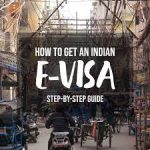Are you tired of long, tedious immigration procedures when traveling to India? Say goodbye to the hassle and hello to convenience with the Indian eVisa! Gone are the days of standing in never-ending queues or drowning in paperwork. In this blog post, we will delve into how this innovative system has revolutionized travel by simplifying immigration procedures at airports. Get ready for a stress-free journey as we unlock the secrets behind obtaining your Indian eVisa effortlessly. Indian eVisa Airports
What is an Indian eVisa?
The Indian eVisa is an electronic travel authorization that allows eligible foreign nationals to enter and travel within India for business, tourism, or medical purposes. The eVisa is valid for a maximum of 60 days from the date of arrival in India and can be used for multiple entries into the country. Eligible applicants must have a valid passport with at least six months of remaining validity and a digital photograph taken within the last six months. Applicants will also need to provide detailed information about their travel plans and purpose of visit.
Benefits of Applying for an Indian eVisa
There are numerous benefits of applying for an Indian eVisa. For starters, it is a much simpler process than the traditional visa application process. You can apply for your visa online and receive it within a few days, without having to go through any complicated procedures at the embassy or consulate.
Another great benefit of the Indian eVisa is that it is valid for multiple entries into the country. So, if you plan on making several trips to India in the near future, you won’t have to go through the hassle of applying for a new visa each time. The eVisa is also valid for a longer period of time than a regular visa, so you can stay in India for up to 60 days on each visit. Indian Visa requirements
The Indian eVisa fee is very reasonable, especially when compared to other visas. So, if you’re looking for a hassle-free and cost-effective way to travel to India, then the Indian eVisa is definitely the way to go!
How to Apply for an Indian eVisa
Assuming you already have a passport, the first thing you need to do is fill out an online application for an Indian eVisa. The website to do this is www.indianvisaonline.gov.in. After you have completed the application, you will need to print out the confirmation page and bring it with you when you travel to India.
When you arrive in India, present your passport and confirmation page at the designated Immigration Counter. You will be asked to fill out a Disembarkation Card and show proof of onward travel out of India. Once your documents have been verified, you will be granted entry into India and issued an Electronic Travel Authorization (ETA). The ETA is valid for a maximum stay of 60 days in India.
Documents Required for the Application Process
To apply for an Indian eVisa, travelers must have a passport with at least six months of remaining validity and two blank pages. They will also need to provide a digital passport photo that meets the requirements outlined on the website. In addition, applicants must have a credit or debit card to pay the visa fee as well as an email address to which their visa can be sent.
Once these requirements are met, travelers can begin the online application process. The first step is to create an account on the Indian eVisa website. From there, applicants will need to fill out basic personal information such as name, date of birth, nationality, and passport number. Next, they will select the type of visa they are applying for and answer questions about their travel plans. Applicants will review and submit their application along with the required documents and payment.
After submitting their application, travelers should receive an email confirmation within three business days. If they do not receive a confirmation or if their application is rejected, they can contact customer support for assistance. Once approved, travelers will receive their eVisa via email which they must print out and bring with them when they travel to India.
Different Types of Indian eVisas
There are different types of Indian eVisas depending on the purpose of travel. The most common type is the tourist visa, which allows travelers to stay in India for up to 60 days. There are also business visas, student visas, and medical visas. Each type of visa has different requirements and restrictions.
The tourist visa is the most popular type of Indian eVisa. It allows travelers to stay in India for up to 60 days and can be obtained easily online. There are no restrictions on activities that can be undertaken while on a tourist visa.
The business visa is designed for those traveling to India on business purposes. It allows travelers to stay in India for up to 90 days and permits multiple entries into the country. Business visas have some restrictions on activities that can be undertaken while in India, such as participation in business meetings or conferences.
The student visa is for foreign nationals who wish to study at an Indian educational institution. It allows students to stay in India for the duration of their studies, up to five years. Student visas have some restrictions on activities that can be undertaken while in India, such as working or interning with an Indian company.
The medical visa is for foreign nationals who need to receive medical treatment in India. It allows patients and their attendants to stay in India for up to six months. Medical visas have some restrictions on activities that can be undertaken while in India, such as working or participating in sports events.
Immigration Procedures at Airports
Assuming that the blog is addressing Indian citizens travelling with an eVisa, the following information applies:
When you arrive at the airport, you will need to present your passport and eVisa to the immigration officer. The officer will then stamp your passport and allow you to enter the country. It is important to note that you must have a valid passport in order to be granted an eVisa.
If you are travelling with a family member who does not have an eVisa, they will need to obtain a visa on arrival. This can be done by filling out a form at the airport and paying a fee. The process is relatively quick and easy, and once approved, your family member will be allowed to enter the country.
Frequently Asked Questions
1. What is an Indian eVisa?
An Indian eVisa is an electronic visa that allows foreign nationals to enter and travel within India for business, tourism, or medical purposes. The eVisa replaces the traditional paper visa, and can be obtained prior to arrival in India.
2. Who is eligible for an Indian eVisa?
Most foreign nationals are eligible for an Indian eVisa, with a few exceptions. Eligible countries include the United States, Canada, the United Kingdom, and Australia, among others. A complete list of eligible countries can be found on the official website of the Government of India.
3. How long is an Indian eVisa valid for?
The Indian eVisa is valid for a period of 60 days from the date of issuance. Within this period, travelers are allowed to enter India multiple times. However, they can only stay in India for a maximum of 30 days at a time.
4. How do I apply for an Indian eVisa?
The application process for an Indian eVisa is simple and can be completed online. Applicants will need to provide personal information such as their name, date of birth, passport details, and travel plans. They will also need to upload a recent passport-style photograph. Once the application is submitted,
Conclusion
We hope this article has shed some light on the Indian eVisa system and how it simplifies immigration procedures at airports. By obtaining an eVisa, travelers can save time and money when entering India, as well as reduce stress related to paperwork processing. With so many advantages that come with applying for an Indian eVisa, we highly recommend using this service if you are planning a trip to India!


